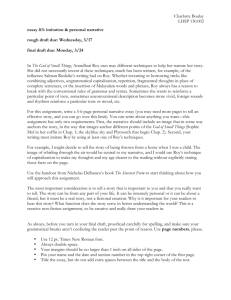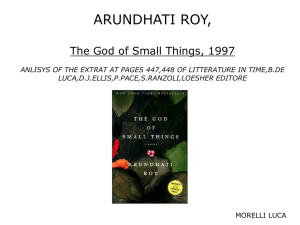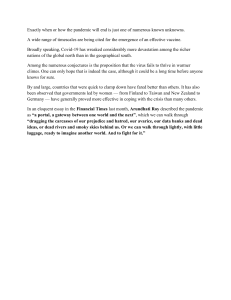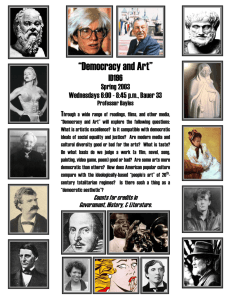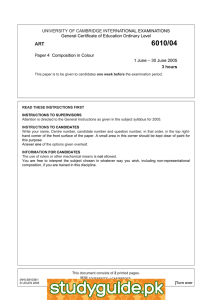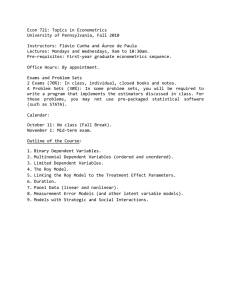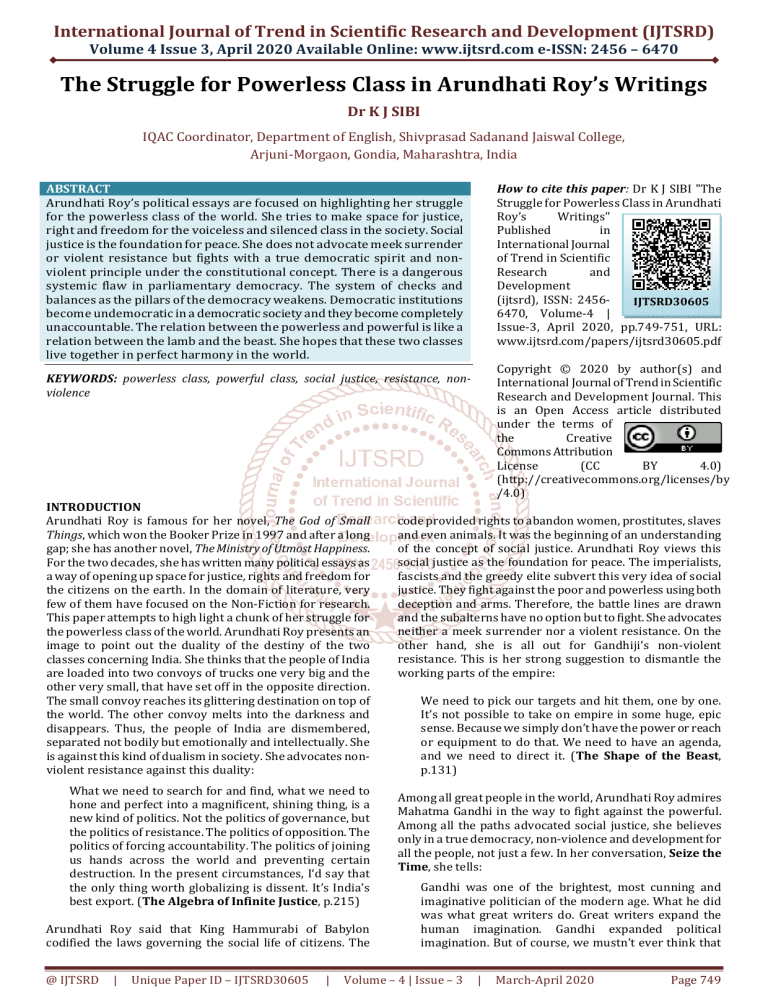
International Journal of Trend in Scientific Research and Development (IJTSRD) Volume 4 Issue 3, April 2020 Available Online: www.ijtsrd.com e-ISSN: 2456 – 6470 The Struggle for Powerless Class in Arundhati Roy’s Writings Dr K J SIBI IQAC Coordinator, Department of English, Shivprasad Sadanand Jaiswal College, Arjuni-Morgaon, Gondia, Maharashtra, India How to cite this paper: Dr K J SIBI "The Struggle for Powerless Class in Arundhati Roy’s Writings" Published in International Journal of Trend in Scientific Research and Development (ijtsrd), ISSN: 2456IJTSRD30605 6470, Volume-4 | Issue-3, April 2020, pp.749-751, URL: www.ijtsrd.com/papers/ijtsrd30605.pdf ABSTRACT Arundhati Roy’s political essays are focused on highlighting her struggle for the powerless class of the world. She tries to make space for justice, right and freedom for the voiceless and silenced class in the society. Social justice is the foundation for peace. She does not advocate meek surrender or violent resistance but fights with a true democratic spirit and nonviolent principle under the constitutional concept. There is a dangerous systemic flaw in parliamentary democracy. The system of checks and balances as the pillars of the democracy weakens. Democratic institutions become undemocratic in a democratic society and they become completely unaccountable. The relation between the powerless and powerful is like a relation between the lamb and the beast. She hopes that these two classes live together in perfect harmony in the world. Copyright © 2020 by author(s) and International Journal of Trend in Scientific Research and Development Journal. This is an Open Access article distributed under the terms of the Creative Commons Attribution License (CC BY 4.0) (http://creativecommons.org/licenses/by /4.0) KEYWORDS: powerless class, powerful class, social justice, resistance, nonviolence INTRODUCTION Arundhati Roy is famous for her novel, The God of Small Things, which won the Booker Prize in 1997 and after a long gap; she has another novel, The Ministry of Utmost Happiness. For the two decades, she has written many political essays as a way of opening up space for justice, rights and freedom for the citizens on the earth. In the domain of literature, very few of them have focused on the Non-Fiction for research. This paper attempts to high light a chunk of her struggle for the powerless class of the world. Arundhati Roy presents an image to point out the duality of the destiny of the two classes concerning India. She thinks that the people of India are loaded into two convoys of trucks one very big and the other very small, that have set off in the opposite direction. The small convoy reaches its glittering destination on top of the world. The other convoy melts into the darkness and disappears. Thus, the people of India are dismembered, separated not bodily but emotionally and intellectually. She is against this kind of dualism in society. She advocates nonviolent resistance against this duality: What we need to search for and find, what we need to hone and perfect into a magnificent, shining thing, is a new kind of politics. Not the politics of governance, but the politics of resistance. The politics of opposition. The politics of forcing accountability. The politics of joining us hands across the world and preventing certain destruction. In the present circumstances, I‘d say that the only thing worth globalizing is dissent. It’s India’s best export. (The Algebra of Infinite Justice, p.215) Arundhati Roy said that King Hammurabi of Babylon codified the laws governing the social life of citizens. The @ IJTSRD | Unique Paper ID – IJTSRD30605 | code provided rights to abandon women, prostitutes, slaves and even animals. It was the beginning of an understanding of the concept of social justice. Arundhati Roy views this social justice as the foundation for peace. The imperialists, fascists and the greedy elite subvert this very idea of social justice. They fight against the poor and powerless using both deception and arms. Therefore, the battle lines are drawn and the subalterns have no option but to fight. She advocates neither a meek surrender nor a violent resistance. On the other hand, she is all out for Gandhiji’s non-violent resistance. This is her strong suggestion to dismantle the working parts of the empire: We need to pick our targets and hit them, one by one. It’s not possible to take on empire in some huge, epic sense. Because we simply don’t have the power or reach or equipment to do that. We need to have an agenda, and we need to direct it. (The Shape of the Beast, p.131) Among all great people in the world, Arundhati Roy admires Mahatma Gandhi in the way to fight against the powerful. Among all the paths advocated social justice, she believes only in a true democracy, non-violence and development for all the people, not just a few. In her conversation, Seize the Time, she tells: Gandhi was one of the brightest, most cunning and imaginative politician of the modern age. What he did was what great writers do. Great writers expand the human imagination. Gandhi expanded political imagination. But of course, we mustn’t ever think that Volume – 4 | Issue – 3 | March-April 2020 Page 749 International Journal of Trend in Scientific Research and Development (IJTSRD) @ www.ijtsrd.com eISSN: 2456-6470 the Indian freedom struggle was a revolutionary struggle. It wasn’t. Because the Indian elite stepped very easily into the shoes of the British imperialists. Nor was it only a non-violent struggle, because that’s the other myth, that it was an entirely non-violent struggle. It wasn’t. But what Gandhi did was democratic because of the ways in which he devised strategy. It included a lot of people. He found ways of including masses of people. (The Shape of the Beast, p. 148) She cites the instance of 1931 Dandi March. The decision to break the British salt tax laws was symbolic. Inspired by that, millions of Indians began to make salts. It struck at the economic underpinning of the British Empire. She urges the downtrodden to re-imagine non-violent resistance. There can be not just one strategy but many. Whatever be the strategy, it must be secular, democratic and non-violent. In ‘How deep shall we dig?’, she writes: If our struggle is to be an idealistic one, we cannot really make caveats for the internal injustices that we perpetrate on one another, on women, on children. For example, those fighting communalism cannot term a blind eye to economic injustices. Those fighting dams or the developing projects cannot elide issues of communalism or caste politics in their spheres of influence-even at the cost of short-term success in the immediate campaigns. If opportunism and expediency come at the cost of our beliefs, then there is nothing to separate us from mainstream politicians. If it is justice then we want, it must be justice and equal rights for allnot only for special interest groups with special interest prejudices. That is non-negotiable. (Listening to Grasshopper, p.41) She underlines Gandhiji’s maxim that the means must justify the end. Thus, she incites the common people to fight fearlessly, yet non-violently from a position of strength, on the streets and the mountains and the valleys, not in boardrooms and parliaments and courts. She says, “I think we are on the side of the millions and that is our strength. We must recognize it and work with it.” (The Shape of the Beast, p.155) Arundhati Roy does not believe in the kind of democracy that is being practised in India or elsewhere. She finds a glaring dichotomy between the government and the governed, the common people. Nevertheless, with the elite, this distinction is blurred. The elite anywhere in the world is inseparable from the government. It seems like the state, thinks like the state, speaks like the state. According to her, the governments of many supposedly democratic countries went to war and destruction. In India, the anti-Sikh riots of 1984 and the several pogroms of Muslims since the destruction of Babri Masjid were neatly executed under democratic dispensation and the perpetrators were protected from any kind of serious action from the police or the government or the courts. Thousands of poor Adivasis were accused of being Maoists and charged under POTA. In the police stations, the ordinary people are forced to drink urine, given an electric shock, burnt with cigarette butts etc. Sometimes beaten and kicked to death. In her words: @ IJTSRD | Unique Paper ID – IJTSRD30605 | The space for genuine non-violent civil disobedience is atrophying. In the era of corporate globalization, poverty is a crime, and protesting against further impoverishment is terrorism. In the era of the War on Terror, poverty is being slyly conflated with terrorism. (An Ordinary Person Guide to Empire, p.102) She warns against closing down every avenue of non-violent dissent, which will provide an opening ground to militants, terrorists and insurgents. She calls upon those involved in resistance movements to reclaim the space for civil disobedience by liberating themselves from being manipulated and perverted to head off in the wrong direction. The politicians and the political parties that run the country do not foster democracy. Every political party has exploited religious and national feelings for its electoral advantage. This has weakened the secular and national fabric of India. However, she feels that it is futile to go on blaming the politicians and demanding from them a morality they are incapable of doing it. In her essay, ‘Democracy’, she writes, “If they’ve let us down it’s only because we’ve allowed them to do. It could be argued that civil society has failed its leaders as much as leaders have failed civil society.” (The Algebra of Infinite Justice, p.102) According to her, there is a dangerous systemic flaw in Indian parliamentary democracy that the politicians will exploit at the least provocation and instigate conflagrations of any magnitude for them to come to power. She thinks that the crisis in modern democracy is a profound one. The system of checks and balances as the pillars of democracy weakens. The free market has changed the face of the free election, the free press and independent judiciary reduced as a commodity available on sale to the highest bidder. The Supreme Court judgement on the Sardar Sarover dam went against the interest of the affected people. According to Arundhati Roy, the Narmada Bachao Andolan is not just fighting big dams. It is fighting democratically, using nonviolent resistance to open the eyes of the authority. She calls it Non-violence Bachao Andolan. The NBA is not against development or democracy. It is demanding more modernity, not less. It is demanding more democracy, not less. Unfortunately, the world over, nonviolent resistance movement are being crushed and broken by the brutal force of the state. If a peaceful change has not been given, a chance, violent change becomes inevitable. This is what is happening in Kashmir, the North-Eastern states and Andhra Pradesh. The millions of affected people, when the ruling class of the country belied all their hopes, looked forward to getting justice from the Supreme Court. The highest seat of justice in the country also let them down by giving into the interest of the self-motivated neoliberalists. When Arundhati Roy raised her voice against the verdict, she was put behind bars on charges of contempt of court. Before she was taken to jail, she courageously said that she stood by what she had said. “The dignity of the court will be upheld by the quality of their judgements; the quality of their judgements will be assessed by the people of this country.” (Frontline, 29 March 2002, p.32) Volume – 4 | Issue – 3 | March-April 2020 Page 750 International Journal of Trend in Scientific Research and Development (IJTSRD) @ www.ijtsrd.com eISSN: 2456-6470 She points out that the same court had found enough cause in 1994 to hold up construction works for six years. However, in 2002, the Supreme Court made a somersault and washed its hands saying that once the government began work on a project, incurring costs, it has no role to play. The verdict was a violation of the tribunal awards and it indirectly endorsed the violation of human rights to life and livelihood. In her talk with N.Ram, she asserts: With this single statement, the supreme court of India is abdicating its supreme responsibility. If the court has no role to play in arbitrating between the state and its citizens in the matter of violations of human rights, then what is it here for? If justice isn’t a court’s business, then what is? (The Shape of the Beast, p.45) In a true democracy, there are cheques and balances, not hierarchies. No one can criticize the Supreme Court or call it to account because of the Contempt of Court law. The politicians are, she tells David Barsamian, accountable to the people at least every five years: But the bureaucracy and the judiciary are completely unaccountable. Nobody understands the terrifying role that the judiciary is playing India today. The Supreme Court is taking the most unbelievable positions. Its decisions affected the lives of millions of people. Yet to criticize its judges is a criminal offence. (The Shape of the Beast, p.83) She wonders how there can be an undemocratic institution in a democratic society. Naturally, the court would accumulate authority, which would end in judicial dictatorship. That was what happened with Sardar Sarovar verdict. Arundhati Roy is the only renowned champion for the rights of the underprivileged class not only in India but also in every country. Since she hails from India, she has a greater understanding of Indian society. Her struggle is not localized, not nationalized but globalized. Just as the earth is divided into the northern and southern hemisphere, the world’s population is segregated into the powerful and the powerless. She is pained at the injustice meted out to the powerless by the powerful. @ IJTSRD | Unique Paper ID – IJTSRD30605 | Yet she does not propagate the Marxian antagonism against the bourgeois but the Gandhian philosophy of converting the powerful through non-violence. She opposes their policies tooth and nail but not them. She does not seek their destruction. Addressing an elite gathering after receiving the prestigious French Cultural Award, she declared, ‘I am against the war, not because I am intrinsically anti-American or pro-Taliban. I am fundamentally opposed to violence. I do not believe war can eradicate terrorism.’ What she pleads with the powerful for is to provide social justice and enough space for the poor to live in this small world, follow the rule of the road, and not bully others in the world. What she hopes for is a world of social justice and happiness, where the lamb and the beast, shedding its beastly nature, shall live together in perfect harmony. CONCLUSION Therefore, her voice is the voice in the desert, a voice of the powerless, trying to turn stones into bread for the vulnerable, defenceless and unarmed. Arundhati Roy states, ‘I am prepared to grovel. To humiliate me abjectly, because, in the circumstances, silence would be indefensible.’ She exhorts those who are willing to play their parts in this second-hand play. ‘But let’s not forget that the stakes we’re playing for are huge.’ She dedicates, ‘An Ordinary Person’s Guide to Empire’ published by Penguin Books India, 2005, ‘To those who believe in resistance, who live between hope and impatience and have learned the perils of being reasonable. To those who understand enough to be afraid and yet retain their fury.’ All her non-fiction is addressed to all those who retain the fury at the injustice meted out to those defenceless in the world. References [1] Roy, Arundhati. The Shape of the Beast, New Delhi: Penguin Books India, 2008. Print. [2] Roy, Arundhati. An Ordinary Person’s Guide to Empire, New Delhi: Penguin Books India, 2005. Print. [3] Roy, Arundhati. The Algebra of Infinite Justice, New Delhi: Penguin Books India, 2002. Print. [4] Roy, Arundhati. Listening to Grasshoppers, New Delhi: Penguin Books India, 2009. Print. Volume – 4 | Issue – 3 | March-April 2020 Page 751
